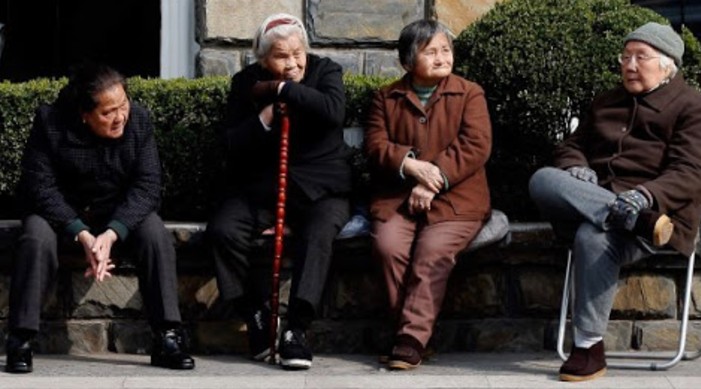The number of elderly people in China is expected to double from 254 million currently to over 500 million in 2050, says a study
Usually Beijing avoids debating issues of high public concern in the People's Political Consultative Conference (CPPCC) of the Communist Party of China. It is a political advisory body of the CPC, where delegates of the party chalk out plans and priority of the government for the coming year.
But when it was convened this year in Beijing from March 4 to March 11, issues related to the aging population and its impact on the growth of the country’s economy and its ambition to become a superpower were discussed. Indeed, concerns over the aging population are giving sleepless nights to Chinese authorities as the number of elderly is expected to double from 254 million today to over 500 million in 2050.
The United Nations Department of Economic and Social Affairs has maintained that China’s elderly population will be 500 million while the working age population—20 to 64—will be around 675 million by 2050. The working-age population has shrunk by some 3.4 million per year over the last decade. Meanwhile, on account of increasing life expectancy, the share of elderly population, aged 60 and above, has risen from 10.45 percent in 2005 to 14.7 percent in 2013 and to 18.1 percent in 2019. According to a Chinese Academy of Social Sciences study, China will get old before it gets rich.
In 2016, one-child norm was abrogated, but the side-effect of one-child policy continues unabated. Preference for boys has led to sex-selective abortions, resulting in imbalance in demography of the country. For every 100 girls, there are 120 boys in China. Besides, a new trend, which is often seen in Western countries and Japan and South Korea also, has caught Chinese males and females in its ossified grip.
For the sake of career, Chinese youth are either delaying their marriages or prefer to remain single without any family to raise and spend money on it. As per a 2017 report of the Chinese Ministry of Civil Affairs, there are 200 million single people in China and this number is still growing.
To discourage such a trend among youth, the Chinese government started shaming them. Singles are called as ‘leftover women’ or ‘leftover males,’ yet the situation remains far from changing. Registrations for marriages have declined annually since 2013, while since 2006, the number of divorces has climbed up. In fact, China’s middle class now doesn’t see marriage as the only path to security.
Those who get into wedlock, they prefer to have a maximum one child. Despite the government’s prodding, more than 50 percent of families have no intention of having a second child, according to a study. Expensive cost of living and fear of their income getting sucked into children’s education and health, have forced millions of Chinese couples to restrict the size of their families.
This has contributed to a negative impact on China’s population, which is expected to peak at 1.44 billion in 2029 before entering unstoppable decline, according to a study by the Chinese Academy of Social Sciences, a Beijing-based premier think-tank.
Already, the country’s fertility rate is on a downward slide falling from 1.49 in 2018 to 1.47 in 2019. Also, there have been fewer than 18 million births over the last decade, compared to 25-30 million during the peak years. In 2019, China registered only 14.65 million newborns. In 2020, that figure dropped to 10.03 million—nearly a 15 percent decline year on year basis and for this sharp decline in births, the coronavirus pandemic has been cited as the reason. Still the downward trend is clear.
The Chinese Academy of Social Sciences has warned that China will enter an era of negative population growth, meaning less domestic consumption and rapidly slowing economic growth. Amidst piling debt burden, which is estimated at three times its GDP, greying population is adding to the woes of Chinese leadership, which has so far managed to legitimize its position and facilitate societal transition by using the benefits of high income growth.
It is felt that managing the spiraling up debt will not be any easier in the future, nor will it be easier for the country to sustain its ambition to become number one economic powerhouse of the world. Rather, China with a smaller workforce and growing fiscal constraints will see its aspirations getting severely hampered by its demographic problems. Experts say that China with the help of technology will manage to ease its problem on the workforce front.
Still there is no guarantee that in the absence of productive human resources, huge development projects like Belt and Road Initiative will not get impacted. Nor is there any surety of China managing to keep its armed forces strong in the absence of young and competent personnel.











 Contact Us
Contact Us
 Subscribe
Subscribe
 News Letter
News Letter
 Instagram
Instagram Youtube
Youtube